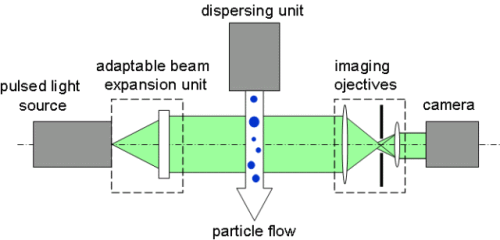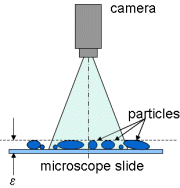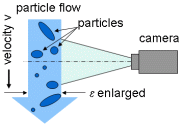|
Image Analysis |
| Fundamentals |
| Overview |
| QICPIC/R |
| PICTOS/R |
| PICTIS/R |
| PICCELL/R |
|
Dispersing Units |
| OASIS/L |
| RODOS/L |
| GRADIS/L |
| FIBROS |
| MIXCEL |
| LIXELL |
| FLOWCELL |
|
Software |
| WINDOX 5 |
|
Accessories |
| Computer |
| VIBRI/L |
| ASPIROS/L |
| LIQXI |
| MULTI- SAMPLER |
| Extraction Units |
| LIQIBACK |
|
Information |
| Publications |
| FAQs |
For the characterisation of real particles the particle shape becomes more and more important in addition to particle size. Image analysis can give valuable service.
For particle size and shape analysis following topics are of decisive importance:
| 1. | Image Analysis is dealing with number statistics. The minimum number of particles can be estimated in terms of the maximum error of the Q0(x) distribution as nmin > 1/E²max.. This results in more than 10,000 particles for a maximum standard deviation of 1%. Often a volume based result Q3(x) is requested. Following ISO 14488 (2003) the minimum number of particles is now depending of the size distribution itself. Typically more than 1,000,000 particles are necessary to reach a maximum error below 1%. | |
| 2. | The particles should be separated from each other. Otherwise time consuming algorithms would have to be used to separate the particles by software. This usually results in low particle numbers per image and high computation times. | |
| 3. | The measuring time should be kept within acceptable limits: 1,000,000 particles with 10 particles on each image would need 100,000 frames to be acquired. With 25 frames per second this results in a measuring time of 4000 seconds, i.e. more than one hour! | |
| 4. | As the border of the particles has to be detected precisely, the particles must be imaged with the highest possible contrast. | |
| 5. | The particles have to be oriented randomly. Otherwise the measured size distribution can be incorrect, as e.g. pellets would be represented always as spheres, resulting in larger volume fractions. |
The basic concept is the combination of well established powerful disperser with dynamic image analysis (DIA). A well dispersed particle flow is led through the image plane. Due to the dispersion the particles are separated from each other by the transportation fluid and overlapping particles are widely avoided. So high particle numbers per image frame can be captured (please refer to topic 2 above).

As the particles are accelerated by the dispersion process, attention has to be paid to a possible motion blur. Commercially available flash lamps with exposure times of typical 100 µs cannot be used, as the motion blur would be as much as 10 mm for particles velocities of 100 m/s. So Sympatec has developed a special pulsed light source with an exposure time of less than 1 ns resulting in a motion blur of only 100 nm for the same velocity. This is below the smallest pixel size of 1 µm and invisible for the camera. So this method has the appearance of a static image analysis.
As the camera and the light source are able to operate at any speed from 0 to 450 frames per second (fps), very high particle counts are acquired in short time: With 100 particle per frame (due to the better dispersion) and 450 fps 1,000,000 particles (please refer to topic 1 above) are now acquired in 20 s, instead of 1 hour (please refer to topic 3 above).
In order to detect the edges of the particle precisely, the particle flow is imaged in transmission using a special imaging objective, which only transmits light rays to the camera which a nearly parallel to the optical axis. In combination with a parallel illumination, even highly transparent particles are imaged 'black', as long as their diffraction index differs from the surrounding fluid and so their light is deflected (please refer to 4 above). Different objectives mounted on a carrousel allow for the selection a specific measuring range by software.
Finally the imageas are captured by a high speed CMOS camera with 2,048 x 2,048 pixel per image, i.e. 4 Mpixel per image. The data a transferred to a PC by a CoaXPress interface with up to 25 Gbit/s or via USB3 with up to 5 Gbit/s. All image data can be transferred and stored in the database of the PC in real time with up to 500 fps @ 4 Mpixel per image.

is characterized by non-moving particles, e. g. on a microscope slide.

The advantages are: The depth of the sharpness is well defined resulting in high resolution for small particles, and the method is well established and standardized in ISO 13322-1. But this method can only handle small amounts of data, the particles are oriented by the base, overlapping particles have to be separated by time consuming software algorithms and the tiny sample size creates a massive sampling problem resulting in very low statistical relevance of the data.
images a flow of moving particles.

This enlarges the sample size. The particles show arbitrary orientation and the number of overlapping particles is reduced. So several companies offer systems which either operate in reflection or transmission, with wet dispersion or free fall, with matrix or line-scan cameras.
Their current limitations are:
The free fall systems are limited to well flowing bulk materials only, dry dispersion is not established. Systems with wet dispersion only allow for smallest samples sizes and slow particles. Common to all are small particle numbers which result in poor statistics. This type of instruments is going to be standardized by ISO 13322-2.